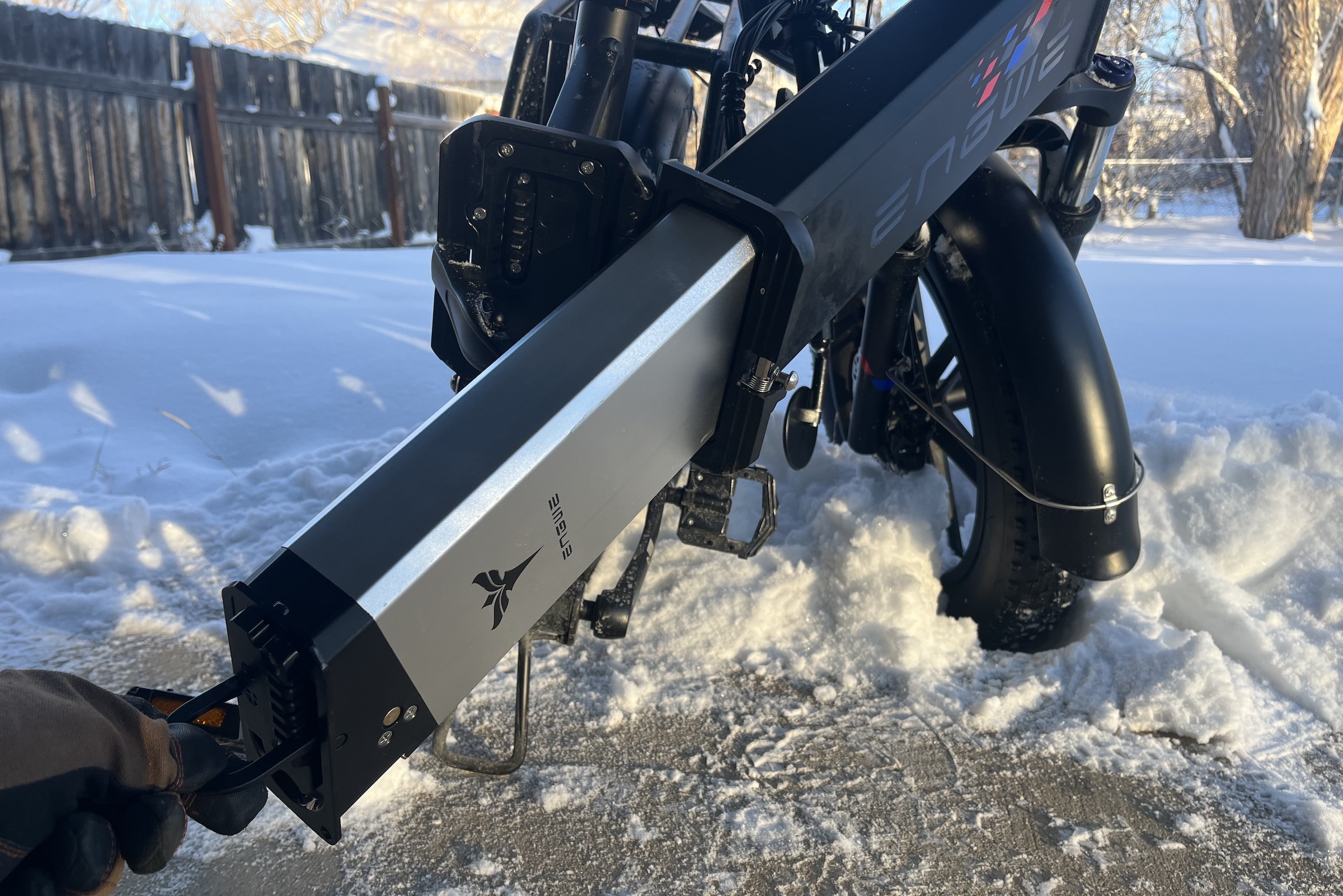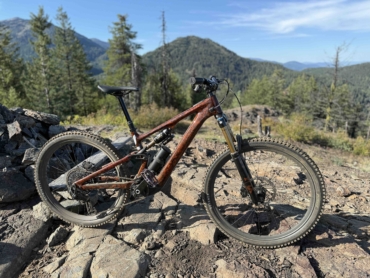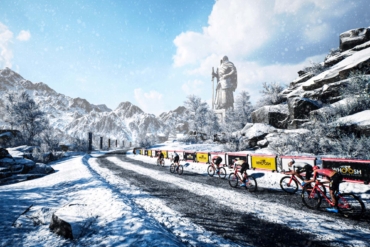Expanding competition in the e-bike market has driven prices down significantly, but it’s still difficult to find quality options for less than $2,000. At $1,449, the Engwe Engine Pro shines in the budget category.
I rode this bike as my everyday about-town commuter for six wintry weeks, and despite a few workable flaws, it impressed at every battery-boosted turn.
In short: Engwe’s Engine Pro is as good as it gets for an e-bike under $1,500. The brushless rear hub motor is responsive and zippy. Though not the highest quality, the front and rear suspensions were cushy enough to absorb impact and vibration on gravel paths and pothole-laden city streets.
At 83 pounds, it’s an absolute heifer — but the collapsible frame and handlebar riser provided some portability. All folded up, the Engine Pro fit into the back of a small hatchback without hassle.
Engwe Engine Pro E-Bike Review
Assembly and “All-Terrain” Claims

Engwe manufactures e-bikes out of Shenzen, China. Though it shipped partially assembled, it took about an hour to liberate it from its box and make it ridable. The setup was simple, though most folks will encounter minor trial-and-error frustration.
The Engine Pro is billed as an “all-terrain” e-bike. It handled modest roughage but don’t buy it if you’re shopping for an e-MTB.
The unbranded front shocks offer about 2.5 inches of travel. They were better than nothing, but I frequently bottomed out on high curbs and speed bumps. In the rear, an HLT-100 shock with a single inch of travel is mounted vertically directly below the seat. Combined with the bike’s 4-inch wide tires, the suspension system provided a smooth ride on graded surfaces.
I tested the Engine Pro in Wyoming, where November storms transformed the roads into a sea of icy bumps. I deflated the tires to 18 psi from the recommended 20, and the bike was comfortable to ride across the full spectrum of urban terrain.
For thorough testing, I rode the Engine Pro down a few stretches of steep, rocky single track. I maintained control at low speeds thanks to the squeaky-yet-responsive hydraulic disc brakes. At higher speeds, it was difficult to maneuver the 83-pound Engine Pro on technical trails. The narrow handlebars, only 22 inches end-to-end, limited maneuverability when the going got tough. Additionally, the rugged terrain brought out a symphony of squeaks and groans from the bike’s seat, fenders, and drivetrain.
Stick to the pavement, gravel, and gentle dirt on the Engine Pro. It’s ultimately a commuter bike with suspension.
Accessories Included
Most essential accessories are included with the Engine Pro. Front and rear lights came semi-installed, and they were just bright enough for occasional evening commutes. Frequent midnight riders will need additional lights, especially in the rear, where the stock taillight was decent at best. It brightened while braking, which was a nice safety feature, but ultimately it was under par. The single-bulb headlight came on automatically in low light, and it was easy to turn on and off via the cockpit controls.
Other accessories include a sturdy kickstand (which required minor adjustment), front and rear fenders, and a heavy-duty rear storage rack. I mounted a standard milk crate onto this rack as a cheap cargo carrier, and it worked like a charm for grocery runs and trips to the post office. The Engine Pro’s total weight capacity is 300 pounds, so a child seat (and passenger) is also possible.

Engwe’s e-bike fleet includes six unique models. The Engine Pro is one of the top-tier options, though the entire range shares similar aesthetics and many core components. For $100 less, Engwe’s Engine X is similar to the Engine Pro, with a slightly less powerful motor, non-LCD display, and a different throttle mechanism.
Electronics, Motor, and Specs
For the spec nerds, the Engine Pro’s battery possesses 16 Ah of electrical charge, which enables the rear hub motor to deliver up to 1,000W of power at any given time. Engwe used to advertise the Engine Pro at 750W, but now it claims 1,000W at its peak — even though the actual components haven’t changed. According to the display, I occasionally pulled more than 750W while riding, but I maxed out at around 900W. Compared to other similarly-priced e-bikes on the market, the Engine Pro’s on-paper stats are competitive. The resulting performance was at least as good as the specs suggest.
Upon assembling the Engine Pro, I removed the battery from the foldable frame and charged it from 55% to 100% in about four hours. Charging the battery did not require removal from the frame, but it was nice to have the option. The included charging cable has a built-in fan to prevent overheating, and it makes a mildly annoying humming noise.

Engwe claims that the Engine Pro gets 75 miles per charge in pedal assist mode. Ultimately, every e-bike’s range fluctuates depending on how it’s used.
The Engine Pro offers three modes: Eco, Normal, and Sport. Again, these are fairly standard options for e-bikes. Each mode includes levels 0-5. While riding on 0 in any mode, the Engine Pro worked like a pedal bike. Arrow-shaped toggles shifted between levels. Starting in level 1, a subtle pedal assist is turned on automatically.
I rode the Engine Pro on mostly flat city streets, primarily at a casual pedal-assisted pace. I tended to hang out in sport mode on levels 2 and 3, which was a safe yet efficient combo.
My first full charge lasted 40 miles spread out over three weeks. On my second full charge, I attempted to pedal constantly and utilize less assistance from the battery. I rode 55 miles before the battery fully depleted. Once the displayed battery percentage dropped below 10%, there was a noticeable drop in performance. Pedal-assist mode still worked when the charge was low, but power levels 4 and 5 began to feel like levels 1 and 2.
I tested the Engine Pro during winter in Wyoming, and the consistently freezing air hindered the bike’s performance. Lithium batteries are notoriously vulnerable to the cold. On one bitter 12-degree Fahrenheit ride, the battery percentage level dropped from 100% to 0% in just one mile. The Engine Pro’s functionality plummets in sub-30 F temps based on my testing. If you plan on commuting or want to ride in winter, be sure to factor this in.
All told, this bike had a respectable range. The Engine Pro had a competent set of electrical components for short-trip commuters willing to pedal actively.

I was impressed by the spokeless 20-inch wheels, which easily rolled over tree roots and offset sidewalk panels. They were also small enough for sensible portability— larger wheels would have been a hassle to fit into a car. The hydraulic Larsen disc brakes were responsive. I appreciated that Engwe outfitted such a heavy bike with a suitable braking system. The eight-speed Shimano transmission shifted smoothly, even when caked in mud and ice. A USB port is incorporated into the cockpit for phone charging on the go.
The Engine Pro has external braking and electrical cables. It’s unreasonable to expect internally routed cables on a $1,500 e-bike, but the girthy bundle that runs along the frame and handlebar riser was a hazard and eyesore. I was concerned that the floppy exposed cables might catch on something while riding, so I used zip ties to streamline them.
Display Details, Throttle, and Pedal-Assist Modes
The cockpit screen displays battery life as a percentage. This was a handy feature, but it was also erratic and unreliable. Once, the display suddenly dipped from 90% to 18% while climbing a steep hill. After I crested the hill and returned to level ground, it shot back up to 75%. When the battery is fully charged, the display will read 100% for 4-5 miles, even though 5 miles is about 10% of the bike’s actual range. The displayed percentage was an okay reference point, but it was far from an accurate reading.
The screen was easy to see in all light conditions and user-friendly. There’s a button to change modes and up and down arrows to adjust levels. The electronic horn made an awful noise and wasn’t very loud, but it was easy to access and worked whenever I needed it.
In all modes and settings, the pedal assist took about one second to kick in, and it continued for about 2 seconds after I stopped pedaling. At first, the power delivery felt abrupt and jarring, especially in higher settings. After a few rides, though, it began to feel natural. It’s possible to adjust the pedal assist delivery rate, but I didn’t feel it was necessary.

While climbing hills with a grade of 10% or more, I had to ramp up to Sport mode level 4 to avoid breaking a sweat. Level 5 offered more power and acceleration than I needed while traveling in busy urban areas, but it was helpful on relatively straight bike paths and wide-open bike lanes.
Eco mode was gentle at every level and was only my go-to option while trying to save battery power. The difference between Eco, Normal, and Sport was only noticeable in the higher levels of 3, 4, and 5. Sport mode’s level 5 felt like a moped — especially when I used the throttle without pedaling. On a long flat stretch, I accelerated from zero to 25 mph in just over 6 seconds and managed to hit 30 for a fleeting instant. The Engine Pro was quite peppy for an unassuming folding bike.
We’re used to right-handed throttles in the U.S., so the Engine Pro’s lefty thumb throttle required a mental adjustment. The high-speed throttle-only option of the Engine Pro makes it a class 3 e-bike, which limits its legality in certain areas. While its advertised top speed of 24 mph isn’t the fastest on the market, it was sufficient for practical applications.
Ramping up to Sport level 5 and laying onto the throttle was a thrill, but it also depleted the battery at lightning speed. According to the display, one full minute of throttled cruising in Sport level 5 reduced the battery from 70% to 29%. Excessive throttling on the Engine Pro could result in a frustrating, human-powered ride home. The Engine Pro isn’t a moped, even if it felt like one in brief moments of glory.
Possible Upgrades and Regenerative Charging
I tested the Engine Pro in November and December and pushed its on-snow capability to the limit. Thanks to the 4-inch-wide tires, I felt secure on shallow slush and snow-dusted asphalt at low speeds. Despite the tire’s generous surface area, the tread is scattered and relatively shallow. I slid all over the place in deep snow and mud. The metal folding pedals don’t have any texture and become slick when wet. The Engine Pro would need various upgrades to become a proper snow-ready all-terrain fat bike.
Like many other EVs, the Engine Pro has regenerative charging technology. Under specific conditions, it’s possible to send power back into the battery and increase its total range. In my experience, this feature was more of a marketing ploy than a practical reality, though it did technically work.

To activate the regenerative system, I had to pedal vigorously in pedal assist modes 0 or 1. When the regeneration kicked in, the display showed how much wattage I was delivering back to the battery. When pedaling as hard as possible while riding downhill in Eco mode 0, I managed to input up to 400W to the battery in brief intervals.
It was difficult to know how much I actually recharged the battery, mainly because the displayed battery percentage fluctuated up and down. While commuting on primarily flat terrain, I rarely activated regeneration. Folks who live in hilly areas might get more out of this potentially valuable feature.
Shop NowEngwe Engine Pro: Conclusions
For folks seeking an everyday e-bike for short commutes, the Engwe Engine Pro is a great value. It’s a class 3 model — you don’t have to pedal to ride this bike. Still, it performed best when the motor was combined with good old human pedal power. It never hit the advertised 75-mile range, but I managed a respectable 55 miles on a single charge while riding in various pedal-assisted modes.
The Engwe Engine Pro is not a high-end e-bike but is a good option for under $1,500. It fell short of Engwe’s all-terrain claims, but with a few add-on components, its utility could be vastly improved for under $2,000 spent.
A wider set of handlebars, superior lights, studded pedals, deeper tread tires, and a winterized battery would take the Engine Pro to the next level.









